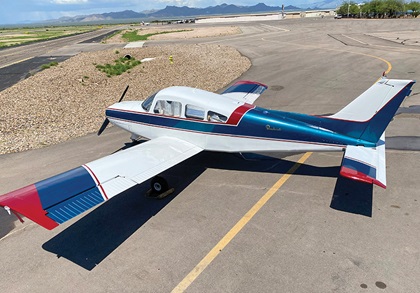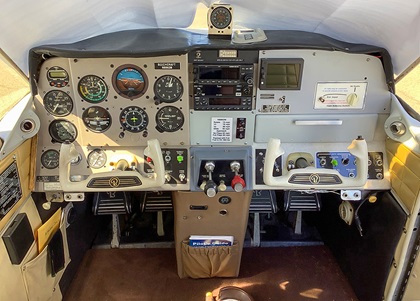My COVID project
Bringing a hangar queen back to life
By Ben Moses
A half-century ago, one month after getting my private ticket and with 60 hours in my logbook, I bought a two-year-old Beechcraft Musketeer and parked it at Teterboro Airport (TEB) in New Jersey, across the river from New York City. I got my instrument rating in it and flew the fun little bird around the East Coast for years.

In the years since, I’ve had a wonderful life in general aviation, moving into bigger and faster craft, peaking in a beautiful Piper (Ted Smith) Aerostar. When kids came along, I downsized to a Beech Sierra, which took us across the United States a couple times and to many airports in the West. I sold it in 2017 when we moved to Europe.

We returned in 2020 to Los Angeles, just in time for COVID-19 and the era of seclusion. Not used to hibernating, I knew it was time to sit behind a propeller again. I found a low-time 1960s Musketeer hiding in Alabama, barely flown in five years—an aircraft much like my first little BE23 from the 1970s. Bringing this airplane back to life would be a great way to spend my COVID isolation, and it was the perfect place to bury my pain from the death of our daughter that had occurred a month earlier.
I learned that Rap McBurney, former president of the Beech Aero Club and renowned baby-Beech expert, was based at the very same Alabama airport. He offered to annual the airplane there, making sure it was airworthy again. Coincidence? “Meant to be,” was my feeling.
But I couldn’t pull myself out of my malaise to go get it, so my friend Marty Vanover—A&P and ex-southwest regional director of the Beech Club—volunteered to go visit Rap and fly the Mouse back to his Marana (Tucson) hangar where we could work on it. My wife’s mother lived in Tucson and had a spare bedroom. Did I say “meant to be”? What’s the next level up from that? I bought the airplane.
I asked Marty if he was OK hand-flying a 50-year-old airplane across the sweltering summer south with no autopilot. “Autopilot? Real pilots don’t need no stinkin’ autopilot!” he cracked. (If he changed his mind en route, he never admitted it.)
Once back home he kicked off his shoes, poured a tall glass of wine, and called me: “Well, the engine ran OK but one cylinder runs warm; the ailerons are out of rig; it won’t fly level without help; I had to navigate with my phone ’cause the ancient GPS/com is impossible to read in daylight; the number 2 radio squealed so loud on transmit I couldn’t use it; and halfway to Dallas the mic stopped working; I had to find a nontowered airport for fuel. I did spend a nice evening visiting a friend and his wife outside Dallas, and we fixed a broken wire in the mic line so I could at least use one radio. Anyway, if you’re wanting to actually enjoy this machine, we’ve got a lot of work to do.”
I drove to Tucson.
I have an FCC license, so I dug into the number 2 radio and discovered that its sidetone volume was set wide open. When Marty keyed Transmit, the sidetone would feed into his headset so loudly that his mic picked it up, creating a classic feedback loop and destroying any possibility of communication. Easy enough, I thought, but this radio had to be on a test bench to adjust, so I gave it to a radio shop. Frustrating for this old radio guy who for years could tweak settings with a screwdriver, but at least the radio became useful.
Marty re-baffled the engine compartment to deal with the number 3 cylinder’s high cylinder head temperature. It didn’t help. He swapped analyzer probes. Nope. We’d borescope it later.

We tackled aging cables, ducts, and wires, and re-soldered connections. Marty had noticed an unstable fuel flow, so we sent the servo for overhaul. Yep, broken O-ring. (Part: 30 cents. Labor: $300.) The Continental service instruction on fuel flow settings required 2,700 rpm, impossible with a fixed-pitch prop at Marana’s 4,000-foot density altitude. Could we interpolate? We tried adjusting input and output fuel flow by trial and error. When we thought we were close, I ran up the engine on the ground. At full rpm it quit cold. Better in front of the hangar than on takeoff, right?
So, we kept at it until it finally purred. A full-power taxi felt good. So, I decided to fly home to LA for a while and continue some of the tasks there.
Runup and takeoff were uneventful. I headed toward the Buckeye VOR, west of Phoenix. Everything was normal, but one thing felt strange. I noticed when climbing that engine rpm would sag. Was something wrong?
I mentioned this to Marty later and he laughed. “You’ve been flying behind constant speed props for too long, my friend. An engine works harder in climb, and your prop is bolted to the engine, they slow down together.” (Yes, this 3,000-hour pilot was chagrined.)
I leveled off at 6,500 feet, encountered turbulence, and resumed climbing to 8,500. I shoved the throttle to the stop—and the engine quit! I pointed the nose down, pulled the throttle back, and the engine came alive. Whew.
I sat there for a minute; everything was normal again. I was 40 minutes into a three-hour flight, I had a lot of summer desert ahead of me and few pleasant places to land after leaving the Phoenix area. I’d been flying for nearly 50 years, across the Great Lakes, 80 miles of open water to the Bahamas, through rain and snow and even a couple of thunderstorms, but never had an engine quit in flight. I made a one-eighty and told Center I was going back but didn’t tell them why. Then I started silently chanting the mantra I learned from Star Wars guru Obi-Wan Kenobi: “We’re not the ones you’re looking for…”
I radioed Marty. He met me at the hangar, and I briefed him. The service instruction had not been helpful. So, Marty dug out his trusty Beech shop manual and voilà, the right numbers were there. (Sound of man slapping forehead with hand.) We hadn’t been far off, but far enough so that when I jammed in the throttle at altitude, I’d flooded the engine.
Next, we re-rigged the ailerons. The tachometer was erratic, so we greased its cable. Were we done? You’re never done. We found a crack—then more—in the muffler. It spent two weeks at Dawley in Minnesota being made like new. Pulling it was easy. Putting it back on? Exhausting.
The days and expenses were adding up. But I had known before the purchase what I would be facing. I was grateful for the distraction during this difficult period. Thankfully Marty is tolerant and patient; his wife, Claudia, and my mother-in-law were great hosts.
Finally, after many enjoyable and frustrating weeks, the Mouse was ready. I flew home to Whiteman Airport, but during the last 50 miles and across the densest part of the LA Basin, both radios developed so much receiver noise that I couldn’t hear SoCal Approach. No problem, I’ll plug my headset into the handheld. But no. That takes two hands, and I’m flying with one. I wind up holding the handheld up to my headset mic with my free hand so I can hear, flying and keying the airplane’s radio mic to transmit with my other.
On the ground, this was a problem my radio background understood. I pulled the glareshield and sprayed every coax connection with contact cleaner—probably for the first time in 50 years—then reconnected all. The fix worked like a charm. Maybe I could just fly the airplane now?
Well, yes, but…one air vent was frozen shut. Had to find a new one, replace it, and repaint the shroud. All interior, nuts, screws, overhead masking strip, pull, clean, shine, repaint, replace. New placards, new carpeting, new battery, new voltage regulator. Then one night I left the battery switch on and had to recharge it. (I won’t admit here that I did that twice.)
One morning my wife and I jumped in the airplane to visit friends in Palm Springs but wound up driving. Alternator wasn’t charging. A week later we replaced the starter, too.
In six months or so, with Marty’s lead, we had the airplane in pretty good shape. But there were still two issues. First was the high CHT of cylinder number 3. The borescope showed nothing. I gave up and had the jug redone.
Then there was the half-century-old paint job. I priced paint shops all over and choked. Rap had said, “Just fly the airplane; don’t look at it.” Then one day at Marana, Marty introduced me to a couple of guys on the field who were professional aircraft painters; their clients included the airlines and owners of beautifully restored warbirds. In jest I asked, “You guys ever take on charity cases?”
They didn’t laugh. “Occasionally when we’re not busy, why?” I gestured to my Musketeer and said I could use some help. All I wanted—all I could afford—was maybe for the wings to be cleaned up and painted and some new, big N numbers. To my surprise, they gave me a price I could afford—a “friend of a friend” price—if I could wait until they had free time. Absolutely! A few months later they called. When I got it back the little bird was flat-out beautiful. They hadn’t just repainted the wings, they’d tackled the entire airplane. Once they got started, they just had to keep going; their professionalism wouldn’t let them do a halfway job.
Now my wife and I started flying our newly sexy Mouse around California. But behind a 165-horsepower engine it’s still slow. And the VSI seldom climbs above 600 fpm. And even a simple autopilot for this spoiled aviator would cost close to what the airplane was worth. So, after enjoying the cathartic companionship of my pretty toy during a really rough time in my life, I sold it to a pilot with 60 hours on his new ticket. He’ll love it. And I’ll miss it. The experience was fantastic; it had helped me through the tough time of losing my daughter, and I had made a bunch of new friends.
I must give kudos to the Beech Aero Club where Rap and Marty directed me for advice (probably when they got tired of my calls and emails late at night). It’s full of expert advice from other experienced pilots and A&Ps. But between their gracious help, Claudia’s delicious dinners, my mother-in-law’s kindness, and the two artists’ paint job “gift,” I decided maybe I should change my philosophy. From now on maybe it should be “I am the one you’re looking for.”
Ben Moses is a TV and film writer and producer and a commercial/instrument pilot with more than 3,000 hours.


